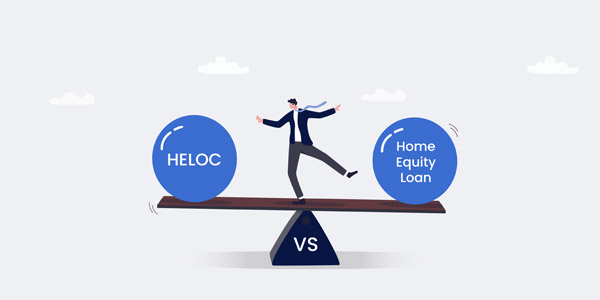Homeowners
HELOC vs. Home Equity Loan: Understanding the Key Differences
April 16, 2024
Two main options for refinancing a home are a home equity line of credit (HELOC) and a home equity loan. Both offer the benefit of tapping into your home's equity. Both are also sometimes called second mortgages. However, the two options have different advantages and drawbacks. It's important to know the differences to make a decision aligned with your short-term and long-term financial goals. Keep reading to dive into HELOC vs home equity loan.
What is Home Equity?
Home equity is defined as the difference between the amount owed on your mortgage and the current value of your home. It determines how much of your home you own. There are two core ways for home equity to grow. The first is by paying down your mortgage. The second happens as a home's value increases due to market conditions. However, home equity can decrease over time if market value declines lower than your purchase price. To determine your home's equity, subtract what you owe on the property from its current value. A $500,000 home with a mortgage balance of $250,000 has a total equity of $250,000.
What is a HELOC?
HELOC stands for home equity line of credit. If you're approved for a HELOC, you can pull from a revolving line of credit to cover expenses in exchange for using your home equity as collateral. For most homeowners, this means everything from funding a home renovation to consolidating other forms of debt.
How does HELOC work? Like a credit card balance, a HELOC's balance is replenished when you make repayments. HELOCs can be beneficial because they often have lower interest rates compared to other loan types. Generally, a HELOC has a variable interest rate that may change with your balance and overall rate fluctuations.
What is a Home Equity Loan?
A home equity loan allows you to borrow money in a lump sum using your equity as collateral. In addition to offering a lump sum instead of ongoing withdrawals, a home equity loan also differs from a HELOC because it generally has a fixed rate instead of a variable rate.
Key Differences Between HELOC and Home Equity Loan
When deciding between a HELOC and a home equity loan, it's important to know how each option fits into your financial goals.
Interest Rates
With its fixed interest rate, a home equity loan works more like a traditional home mortgage. Homeowners who choose this option lock into a lump sum with a fixed rate to create predictable repayments. In contrast, a HELOC typically has a variable rate that causes the cost of borrowing to rise and fall with the federal interest rate.
Payment Structure
A HELOC creates a revolving line of credit that works similarly to a credit card balance. Borrowers can pull from available funds as needed until reaching their credit limit. A home equity loan delivers a set lump sum.
Repayment Terms
The draw period on a HELOC can last five to 15 years for most borrowers. During this period, borrowers are only required to pay interest on what's borrowed. Once the draw period ends, borrowers must repay what they've borrowed with any outstanding interest. A HELOC's repayment period is typically 20 years.
Home equity loans are paid back in uniform monthly payments. A home equity loan's term might last 20 to 30 years.
When to Use HELOC vs Home Equity Loan
Both HELOCs and home equity loans are commonly used among people looking for a home renovation loan. HELOCs can be beneficial in situations where you'd like access to a line of credit to fund smaller projects or purchases. For example, this option can be attractive when you need to draw funds while slowly redoing a home over several years. People also use HELOCs to cover emergency expenses, pay for tuition, or consolidate loans with higher interest rates. A home equity loan can be ideal in a situation where you need a large lump sum to finance a home addition, home renovation, or other major expense.
Pros and Cons of HELOC
While the benefits of HELOC give homeowners the flexibility to only withdraw what they need, this option does come with risks.
HELOC Pros:
- HELOC rates are typically lower compared to interest on other types of loans.
- Long drawing period provides extended access to cash for unexpected expenses.
- Flexibility to only spend what you need.
- Borrowers only pay interest on what they borrow.
- HELOC repayments can boost credit scores.
HELOC Cons:
- Variable interest rates can make repayments unpredictable.
- Ongoing draws can pose a risk of overspending.
- If a home's equity drops, a borrower could end up owing more than a home is worth.
- Failure to repay a HELOC could result in foreclosure.
- Some fees are associated with the loan.
Pros and Cons of Home Equity Loans
While the traditional structure of a home equity loan can make this a good option for many homeowners, it's important to know about potential downsides.
Home Equity Loan Pros:
- Fixed interest rates and lump sums create predictable monthly repayments.
- Long repayment timeline.
- Home equity loan rates are generally lowered compared to traditional loans.
Home Equity Loan Cons:
- Failure to repay a loan can result in the loss of a home.
- Lump payment creates less flexibility compared to a HELOC.
- Lump payment can create a temptation to borrow more than needed simply because it's being offered.
- Risk of negative equity if a home's value declines.
- The borrower will need to pay closing costs associated with the loan.
With its fixed interest rate, a home equity loan offers predictable repayments, while a HELOC's variable rate can rise and fall, impacting borrowing costs.
How to Choose Between a HELOC and a Home Equity Loan
Start by assessing your financial situation and goals. The biggest factor in deciding between HELOC vs. home equity loans is usually the loan's purpose. If you'll be covering a large project or purchase, the lump sum of a home equity loan may be the best route. If you're looking for a low-interest line of credit to fund home projects or cover personal expenses, a HELOC can offer a way to have more control over how much you borrow in total.
It's also important to assess your comfort with a variable or fixed interest rate before making a decision.
Application Process and Requirements
Requirements for HELOCs and home equity loans are nearly identical. In general, a borrower must have the following to qualify:
- Good standing with mortgage payments
- 20% equity in a home
- A solid credit score that is typically in the mid-to-high 600s
- Acceptable debt-to-income (DTI) ratio
- Adequate income
- Up-to-date home appraisal
Like an original mortgage, HELOCs and home equity loans require applications and approval processes. Here's what's involved:
- Find a reputable lender after comparing rates, terms, and available borrowing options.
- Gather W2s, pay stubs, and other documentation confirming proof of income.
- Arrange a home appraisal that helps to determine your property's maximum loan-to-value ratio.
- Submit a completed application.
- If approved, move on to closing.
Approval for HELOCs and home equity loans can take anywhere from a few days to several weeks.
Tax Implications
HELOCs and home equity loans can offer tax deductibility in certain conditions. According to IRS guidelines, borrowers with both options can deduct interest on loans up to $750,000 if they can prove that the funds are being used either to purchase a new home or make improvements on the existing home. Always talk with a tax professional before committing to equity-based financing for tax benefits.







 Smart Moves Start Here.
Smart Moves Start Here.